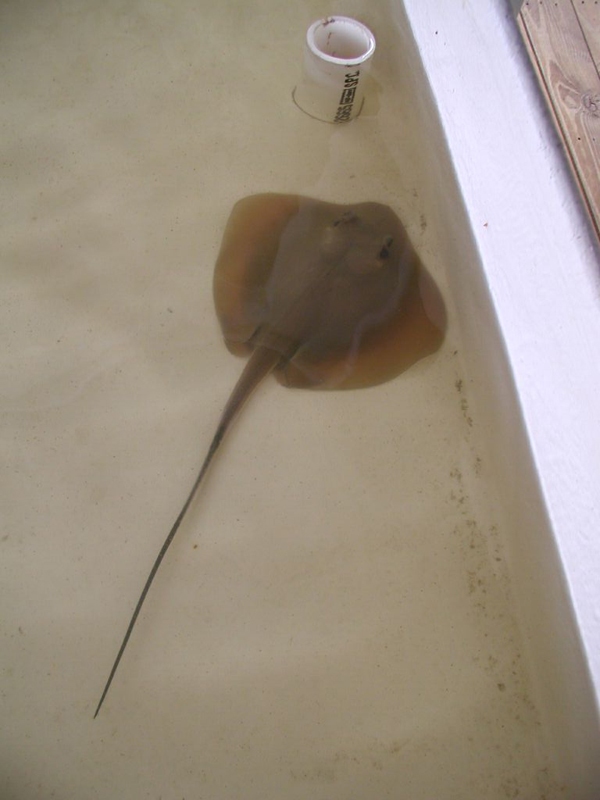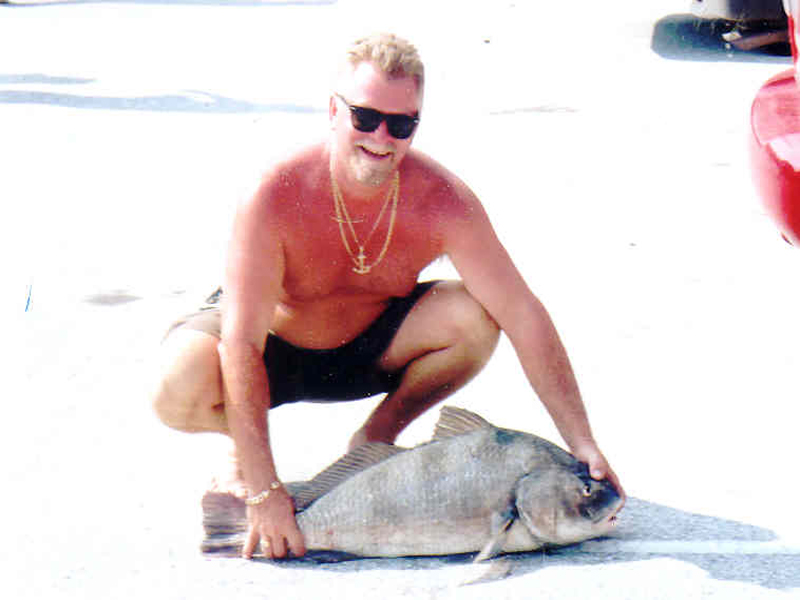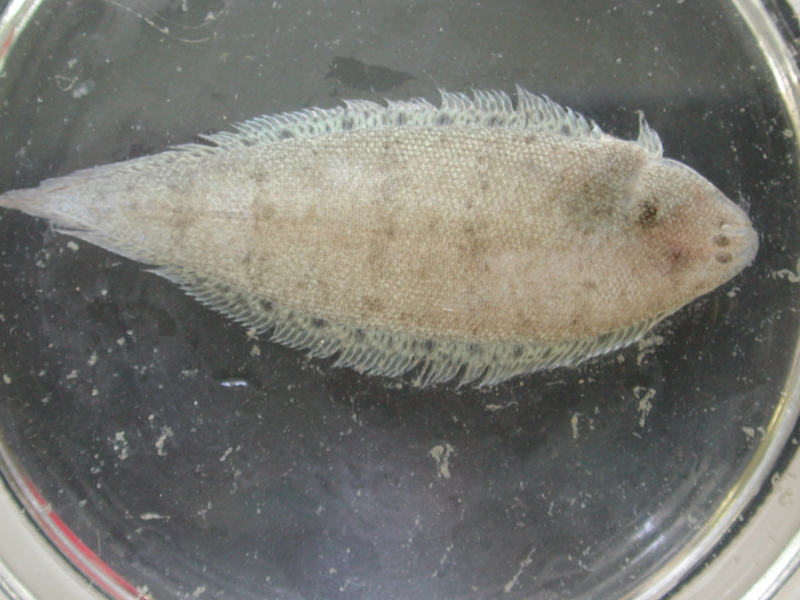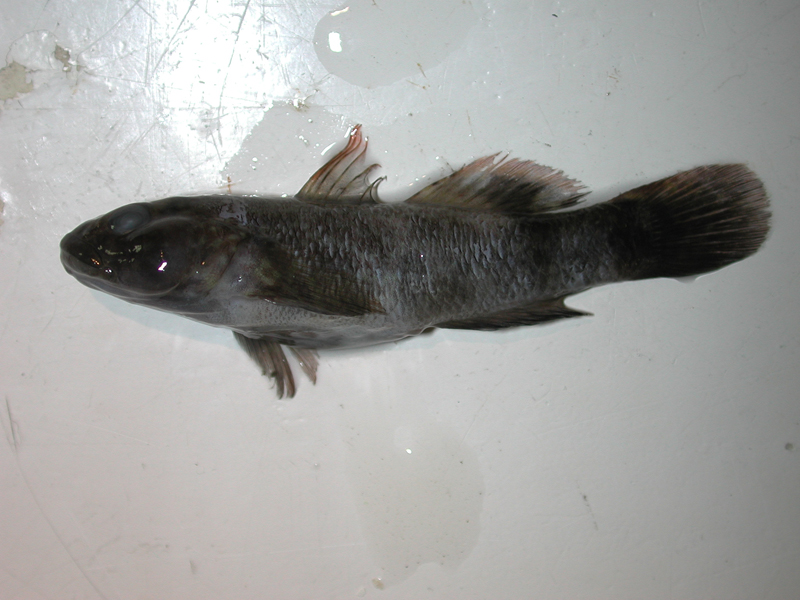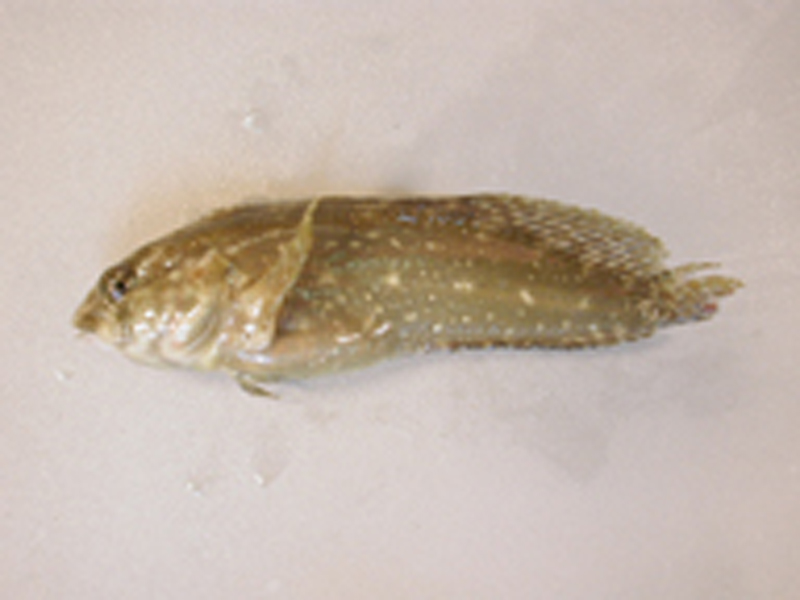Fish-like
Southern Sting Ray
Description
The Southern stingray is common in bays and estuaries of the Gulf of Mexico. Stingrays are bottom animals and typically bury themselves with only the eyes showing. They have a long whip-like tail with a strong serrated spine and venomous tissue near the base. The snout is somewhat pointed and the mouth is ventral, with teeth modified as crushing plates. The body is grey to dark brown. Adults can grow to 3 feet wide.
What Are The Effects On Clams?
Southern stingrays primarily prey on worms but, in doing so, may disturb and expose bags, leaving them vulnerable to predation. Alternatively, their activities may cover nursery bags with excessive sediments, resulting in suffocation of the seed clams.
- FOE
What Can A Clam Farmer Do?
Southern stingrays are not aggressive and are only dangerous if stepped on. The spine can inflict a painful wound that may become infected. Therefore, it is recommended that, before entering the water, growers disturb the bottom with a pole and, once in the water, shuffle their feet to avoid stepping on a stingray. If stung, the grower should flush the wound with seawater, apply heat with an instant heat pack to kill the toxin, and immediately seek medical attention.
Gulf Toad Fish
Description
The gulf toadfish is common in seagrass beds and rocky areas of shallow bays. Small individuals may enter cans, jars, or clam culture bags and become trapped as they grow. Toadfish have large, flattened heads. The tail fin is rounded and the pectoral fins are large and fan-like. Eggs, which are attached to the surface of rock cavities or inside debris, are guarded by the male. Adults may reach 15 inches in length.
What Are The Effects On Clams?
Toadfishes do not eat shellfish but, rather, may feed on predators of shellfish, including crustaceans (crabs) and other fish.
- FRIEND
What Can A Clam Farmer Do?
Shellfish growers in the Northeast have experimented with placing toadfish inside bottom screens, nets, and raceways to reduce crab predation. Toadfishes are belligerent, however, and may bite.
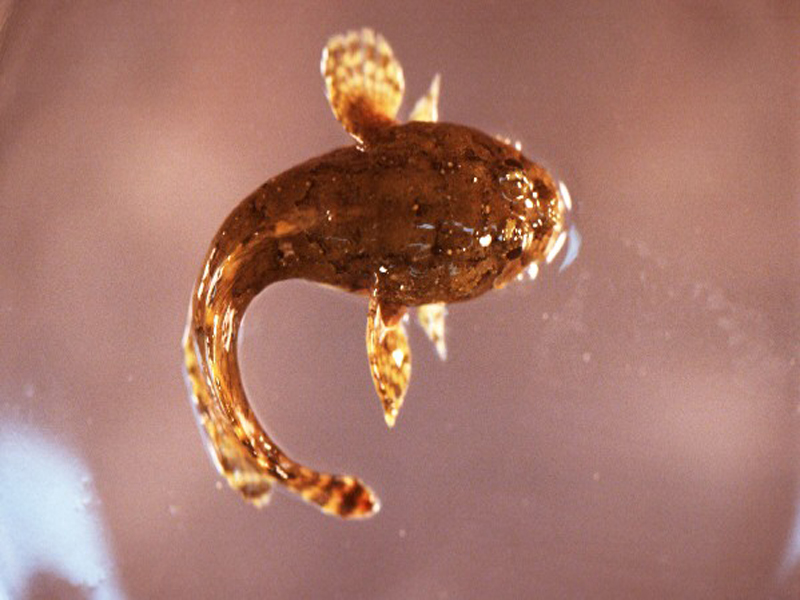
Taxonomy
- Kingdom:Animalia
- Phylum: CHORDATA
- SubPhylum: Vertebrata
- Class: Osteichthyes
- Order: Batrachoidiformes
- Family: Batrachoididae
- Genus: Opsanus
- Species: beta
Black Drum
Description
Black drum are bottom-dwelling fishes found over sand and mud in bays and estuaries, often around oyster beds. They are chunky in size with a high arched back and 10 to 14 pairs of chin barbells or whiskers under their lower jaw. Younger fish have four or five dark vertical bars on their sides but these disappear with age. Adults are slivery to dark gray in coloration, but that can vary greatly. Adults may reach over 100 pounds and 65 inches in length and live to 35 years or more. Black drum form large schools.
What Are The Effects On Clams?
Black drum are primarily carnivores and will consume worms, shrimp, crabs, small fish and mollusks. Barbells, or whiskers, are used to find food by feel and smell. Drum dig and root out mollusks and worms while feeding in a head-down position. This process is called “tailing.” Black drum have been considered one of the most serious threats to the oyster fishery in Louisiana and other Gulf coast states. Schools are often sighted around clam leases on the west coast of Florida. Nursery bags are typically not targeted, however larger seed in growout bags are vulnerable when they are recently planted and have not yet buried into the bottom sediments. Black drum can draw the bag mesh into their mouths, crush the clam shells with pharyngeal (in the throat) teeth, and suck out the meats through the mesh openings. Evidence of predation by black drum includes abrasion of the bag fabric, but typically no holes are found.
- FOE
- Predator
What Can A Clam Farmer Do?
Cover netting may be necessary to reduce black drum predation. Net coatings that stiffen the bag mesh may help prevent the fish from drawing the fabric into their mouths. Specific guidelines for use of net coatings can be found in the Florida Department of Agriculture and Consumer Services, Division of Aquaculture, Technical Bulletin Number 4, 2005. <HYPERLINK TO http://www.floridaaquaculture.com/technicalbulletins.htm> When large schools of black drum are seen on the lease area, typically in spring and summer, growers may want to delay transfer of seed from nursery to growout bags.
Cownose Ray
Description
Cownose rays are cartilaginous fishes found inshore along the Gulf of Mexico during the summer, with schools migrating to the Yucatan Peninsula in the fall. Cownose rays “fly” through the water by flapping their long pointed pectoral fins. They have a pointed tail with a spine at the base. The snout is square with an indentation in the center, resembling a cow’s muzzle. The body is brown to olive, with no spots or markings. The mouth is ventral, with teeth modified as crushing plates. Adults can grow to 7 feet from wingtip to wingtip.
What Are The Effects On Clams?
Cownose rays are voracious predators of bivalve mollusks, including hard clams, which they crush with their dental plates. Food is located by mechanical or electro-receptive detection. To uncover their prey, rays use stirring motions of the fins and blow water to liquefy the sediment. Cownose rays will crush clams right through the mesh of culture bags, consuming the clam meat, and damaging the bag. Large schools can cause extensive damage. Evidence of predation by cownose rays includes butterfly-shaped or paired holes in the clam bag mesh.
- FOE
- Predator
What Can A Clam Farmer Do?
The use of net coatings that stiffen the bag mesh may prevent rays from grasping the firmer material in their mouths. Specific guidelines for use of net coatings can be found in the Florida Department of Agriculture and Consumer Services, Division of Aquaculture, Technical Bulletin Number 4, 2005. <HYPERLINK TO http://www.floridaaquaculture.com/technicalbulletins.htm>
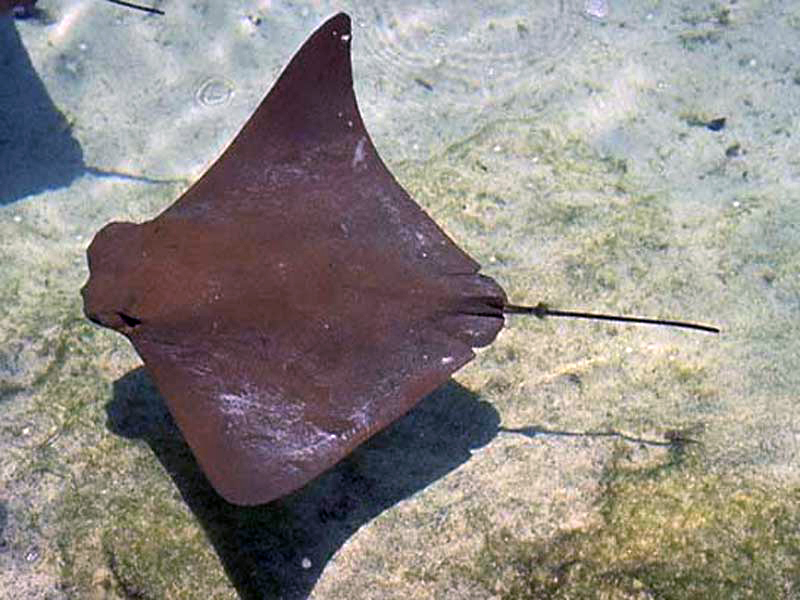
Taxonomy
- Kingdom:Animalia
- Phylum: CHORDATA
- SubPhylum: Vertebrata
- Class: Chondrichthyes
- Order: Myliobatiformes
- Family: Rhinopteridae
- Genus: Rhinoptera
- Species: bonasus
Red Drum
Description
Red drum, also known as redfish, are bottom-dwelling fishes found in seagrass beds and over muddy and sand bottoms. Solitary juveniles and subadults inhabit the shallow waters of bays and sounds, where they are seen swimming about with their dorsal fins protruding from the water. Adults normally occur in open oceanic and gulf waters. The red drum has an elongate body and is coppery-brown to reddish, with a black spot or spots on the base of the tail. This species has no chin whiskers or barbells, like the black drum. On the Gulf of Mexico coast, adults can grow to 40 inches and 40 pounds.
What Are The Effects On Clams?
Red drum are primarily carnivores, preferring fish, crabs, and shrimp. They will consume clams. Nursery bags are not typically targeted. However, larger seed in growout bags are vulnerable when they are recently planted and have not yet buried into the bottom sediments. Red drum can draw the bag mesh into their mouths, crush the clam shells with molar-like teeth, and suck out the meats through the mesh openings. Evidence of predation by red drum includes abrasion of the bag fabric, but typically no holes are found.
- FOE
- Predator
What Can A Clam Farmer Do?
Cover netting may be necessary to reduce red drum predation. Net coatings that stiffen the bag mesh may help prevent the fish from drawing the fabric into their mouths. Specific guidelines for use of net coatings can be found in the Florida Department of Agriculture and Consumer Services, Division of Aquaculture, Technical Bulletin Number 4, 2005. <HYPERLINK TO http://www.floridaaquaculture.com/technicalbulletins.htm>
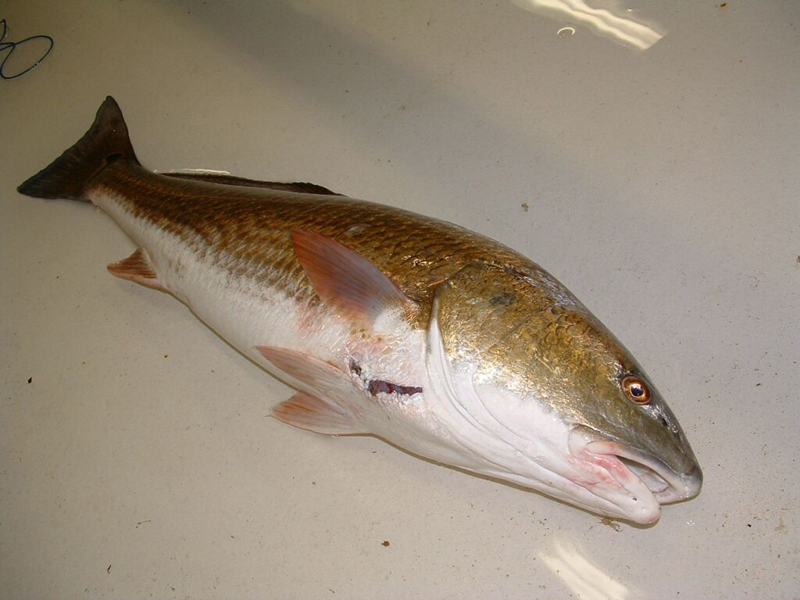
Taxonomy
- Kingdom:Animalia
- Phylum: CHORDATA
- SubPhylum: Vertebrata
- Class: Osteichthyes
- Order: Perciformes
- Family: Sciaenidae
- Genus: Sciaenops
- Species: ocellatus
BlackcheekTongue Fish
Description
The blackcheek tonguefish is an abundant species generally seen over mud bottoms of inshore waters and rarely found deeper than 120 feet. The elongate, tapering flatfish has a small mouth. Eyes, which are very small, are found on the left side of the head. It has a large, black patch on the operculum (gill cover) and varies in color from tan to dark brown with crossbands present or not. The dorsal (top) and anal (bottom) fins are continuous with the pointed caudal (tail) fin, and there are no pectoral (shoulder) fins nor fin spines. This moderately small, slender bottom fish can reach a length of up to 8 inches.
What Are The Effects On Clams?
Tongue fish prey on small invertebrates, such as worms, and otherwise have no known effects on clams.
- NEIGHBOR
What Can A Clam Farmer Do?
No action needs to be taken by a clam farmer.
Gobies
Description
There are more than 2,000 species of gobies and most live in tropical coastal waters. Gobies live in very shallow, protected waters, including seagrass beds and algal mats. They are secretive bottom-dwellers and have protective coloration that matches their backgrounds. Gobies often are not noticed until they make sudden darting movements. Gobies are small and those in the Suwannee Sound area reach only 3-6 inches in length.
What Are The Effects On Clams?
Gobies prey on small shrimp-like organisms, such as amphipods and isopods, and otherwise have no known effects on clams.
- NEIGHBOR
What Can A Clam Farmer Do?
No action needs to be taken by a clam farmer.
Blennies
Description
The combtooth blennies are small fishes that live in and around rocks, reefs and other hard substrates, including clam culture bags. Blennies are territorial and nest in holes such as cans or empty shells. They are recognized by the hair-like or fleshy projections on their heads. The teeth are comb-like. These fish have no scales. Blennies are small and those in the Suwannee Sound area reach no more than 5 inches in length.
What Are The Effects On Clams?
Blennies are herbivores and may help keep clam culture bags clean of fouling macro algae.
- FRIEND
What Can A Clam Farmer Do?
No action needs to be taken by a clam farmer.
